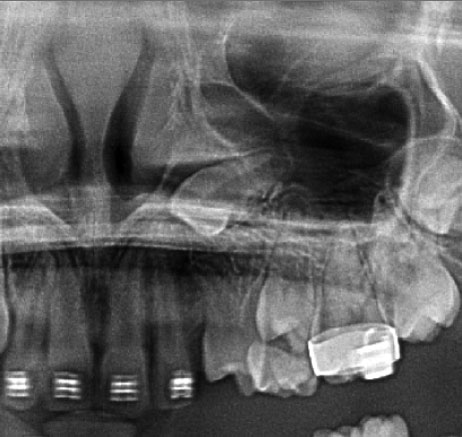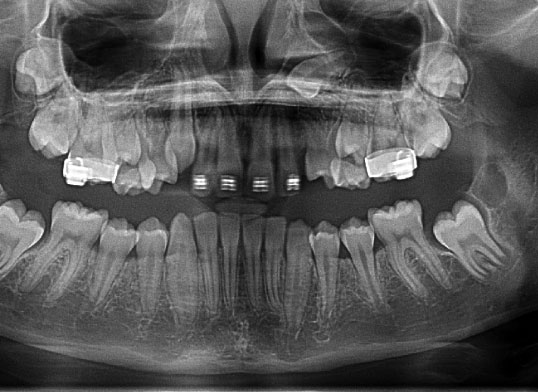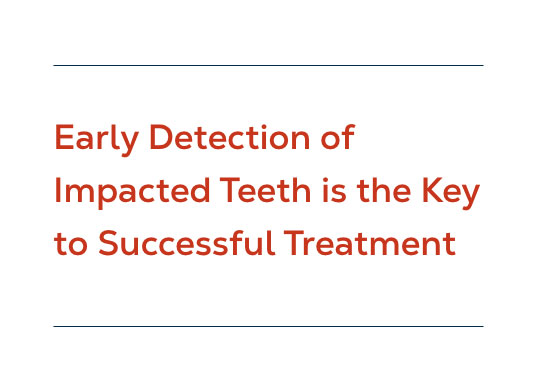Oral Surgery
Impacted Teeth
 An impacted tooth is when a tooth is “stuck or trapped” and cannot erupt or come into the mouth on its own. This can occur with any tooth in the mouth, but most commonly occurs with wisdom teeth and canines. The canine or cuspid is a critical tooth in the dental arch and forms the corner support of the mouth. It plays a key role in your “bite” function and in tearing and chewing food.
Normally the cuspids are the last of the front teeth to erupt into position. If this tooth becomes impacted or erupts into a very awkward position every effort is taken by dental professionals to position this tooth into its proper location because of its importance. If you have an overly delayed or retained baby tooth this is a red flag that you may have an impacted cuspid or another impacted permanent tooth. These teeth should be in the mouth no later than age 13. If you still have your baby teeth past this age, you need to consult with an orthodontist or an oral surgeon to see if treatment is necessary.
The procedure to aid the eruption of impacted or ectopic cuspids can be applied to any other tooth in the dental arch. Long-term damage can occur to adjacent healthy teeth as a result of one or more impacted teeth.
An impacted tooth is when a tooth is “stuck or trapped” and cannot erupt or come into the mouth on its own. This can occur with any tooth in the mouth, but most commonly occurs with wisdom teeth and canines. The canine or cuspid is a critical tooth in the dental arch and forms the corner support of the mouth. It plays a key role in your “bite” function and in tearing and chewing food.
Normally the cuspids are the last of the front teeth to erupt into position. If this tooth becomes impacted or erupts into a very awkward position every effort is taken by dental professionals to position this tooth into its proper location because of its importance. If you have an overly delayed or retained baby tooth this is a red flag that you may have an impacted cuspid or another impacted permanent tooth. These teeth should be in the mouth no later than age 13. If you still have your baby teeth past this age, you need to consult with an orthodontist or an oral surgeon to see if treatment is necessary.
The procedure to aid the eruption of impacted or ectopic cuspids can be applied to any other tooth in the dental arch. Long-term damage can occur to adjacent healthy teeth as a result of one or more impacted teeth. 

The American Association of Orthodontists recommends that a panoramic x-ray be taken by the age of 7 along with a dental exam for all patients to determine if there are potential or developing problems. This x-ray shows the orthodontist if all permanent teeth are present and if there will be adequate space for the developing teeth. Extreme crowding is the most common reason teeth become impacted. However, impacted teeth sometimes occur even when there is enough space, but the tooth decides to track off-course into an abnormal position.
Treatment will involve the collaboration of an oral surgeon and orthodontist to access the tooth, apply a brace and guide the tooth into the dental arch. The sooner the problem is identified and correction is initiated, the greater the chance of success and the less treatment that may be necessary for correction. In adult patients, typically over 40, the tooth will be more difficult to correct and the more likely it is to be fused to the bone. If the tooth will not move, the only option would be extraction.
The procedure to uncover and attach a brace to the tooth is called an “expose and bond”. A simple surgical procedure is done by the oral surgeon to lift the gum tissue and uncover the hidden tooth. A brace with a chain is attached and the tissue repositioned. The chain will be visible and available for the orthodontist to apply pressure to guide the tooth into the correct location within the mouth. The guided eruption can take weeks or months depending on the complexity of the tooth’s position and the age of the patient.
